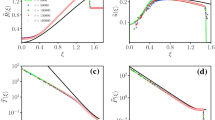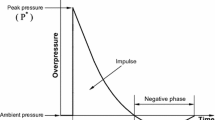Abstract
Effects of viscosity and vibrational nonequilibrium on the profile of a weak, spherical N-wave in air are experimentally and numerically studied. Weak blast waves were generated, in a quiescent air dome, by spark discharges and exploding wires and observed by high frequency response microphones over 40 meters. Some similarity relationships were obtained from the blast wave experiments. For observed N-waves having less than 100 Pa peak overpressure, the peak overpressure Δp f and the duration of the positive phaset d+ are found to vary with the radial distance from the sourcer as Δp f ∝r −1.38 andt d + ∝r 0.19, whilst the rise time of the blast wave Δt f linearly increases with distance. Similar trends were also found for the negative phase of the blast wave. Numerical simulations were carried out to compare with the blast wave data. The Navier-Stokes equations for spherical symmetric flows were solved by coupling with a relaxation equation for vibrational excitation of oxygen using the random choice method (RCM) adapted to supercomputing with an operator splitting technique. The resultant N-wave profiles are in good agreement with the experimental results. The numerical results clearly indicate that the wave-easing process due to the dispersive effect of vibrational relaxation plays a dominant role in determining the rise time of the N-wave.
Similar content being viewed by others
References
Anderson MO (1974) The propagation of a spherical N-wave in an absorbing medium and its diffraction by a circular aperture. Appl Res Lab Univ Texas Austin ARL-TR-74-25
Baker WE (1973) Explosions in air. University of Texas Press, Austin
Bass HE, Ezell J (1983) Effects of vibrational relaxation on rise times of shock waves in the atmosphere. J Acoust Soc Am 74:1514–1517
Bass HE, Raspet R (1978) Vibrational relaxation effects on the atmospheric attenuation and rise times of explosion waves. J Acoust Soc Am 64:1208–1210
Collela P (1982) Glimm's method for gasdynamics. J Sci Atat Comp SIAM 3:76–109
Holst-Jensen O (1981) An experimental investigation of rise times of very weak shock waves. UTIAS TN 229
Honma H, Glass II (1984) Weak spherical shock-wave transition of N-waves in air with vibrational excitation. Proc R Soc London A391:55–83
Honma H, Tsukamoto A (1988) Numerical analysis of weak blast waves in air. Theoret Appl Mech 36: 195–201
Honma H, Xu DQ, Glass II (1990) Nonlinear effects on weak spherical N-waves in air with vibrational excitation. In: Yasuhara M, Daiguji H (eds) Proc ISCFD Nagoya 1989 In: Yasuhara M, Daiguchi H, Oshima K (eds) Numerical methods in fluid dynamics III, Japan Soc Comp F Dynamics pp 985–963
Johannesen NH, Hodgson JP (1979) The physics of weak shock waves in gases. Rep Prog Phys 42:629–676
Lighthill MJ (1956) Viscosity effects in sound waves of finite amplitude. In: Bachelor GK, Davies RM (eds) Survey in mechanics. Cambridge University Press Cambridge, pp 250–351
Niedzwiecki A, Ribner HS (1978) Subjective loudness of N-wave sonic booms. J Acoust Soc Am 64:1617–1621
Orenetein LB (1982) The rise time of N waves produced by sparks. Appl Res Univ Texas Austin, ARL-TR-82-51
Reed JW (1977) Atmospheric attenuation of explosion waves. J Acoust Soc Am 61:39–47
Ribner HS, Morris PJ, Chu WH (1973) Laboratory simulation of development of superbooms by atmospheric turbulence. J Acoust Soc Am 53:926–928
Sachdev PL, Tikekar VG, Nair RC (1986) Evolution and decay of spherical and cylindrical N-waves. J Fluid Mech 172:347–371
Shield FD, Bass HE (1977) Atmospheric absorption of high frequency noise and application to fractional-octave bands. NASA CR-2760
Taylor GI (1910) The conditions necessary for discontinuous motion in gases. Proc R Soc London A34:371–377
Tubb PE (1975) Measured effects of turbulence on the rise time of a weak shock. AIAA Paper 75-543
Wong GH (1984) An experimental and numerical study of weak spherical N-waves produced by exploding wires. UTIAS TN 248
Author information
Authors and Affiliations
Additional information
This article was processed using Springer-Verlag TEX Shock Waves macro package 1990.
Rights and permissions
About this article
Cite this article
Honma, H., Glass, I.I., Wong, C.H. et al. Experimental and numerical studies of weak blast waves in air. Shock Waves 1, 111–119 (1991). https://doi.org/10.1007/BF01414906
Received:
Accepted:
Issue Date:
DOI: https://doi.org/10.1007/BF01414906




